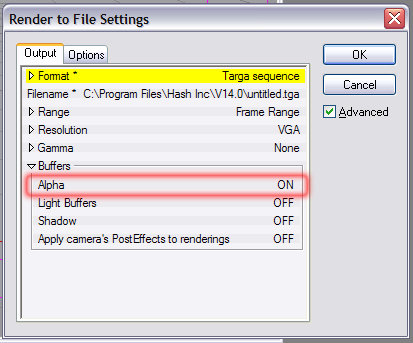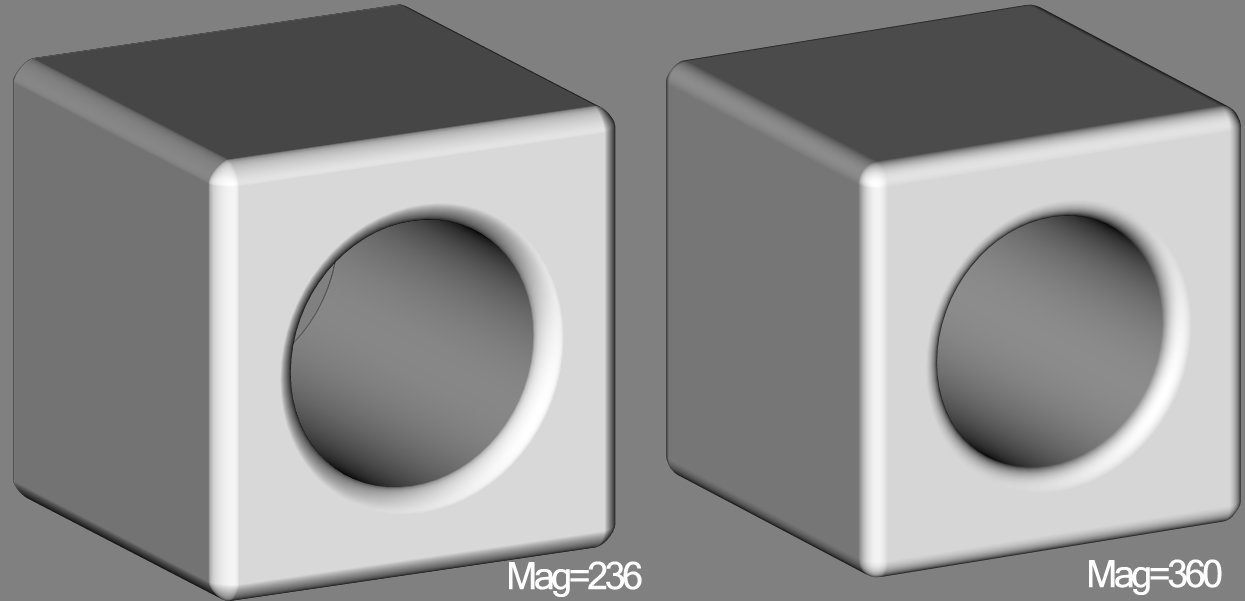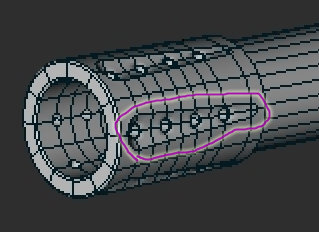
jpappas
Hash Fellow-
Posts
476 -
Joined
-
Last visited
Profile Information
-
Name
Jim Pappas
-
Location
New Hampshire
Previous Fields
-
Hardware Platform
Windows
-
System Description
P4 2.4 GHz, 1 Gb RAM
jpappas's Achievements

Craftsman (5/10)
0
Reputation
-
For A:M versions that need the CD, it only checks the CD when the program first starts up, once started you can remove the CD. It shouldn't be running slower in anyway, unless you possibly have a slower CD drive and you access the CD for the Data folder (containing the included models, materials, etc..) If this is the case you can easily copy the data folder to your hard drive. You could also upgrade to A:M version 15, only costs $50. This version runs without the CD and is only runable on the computer you install it to. -Jim
-
phatso, I always thought the advantage of adding Lights directly into a model were more evident in cases where the light was an intrinsic part of the model, like a car's headlights, or the beam from a flashlight, or a large spaceship with lights around it's hull. In these cases it seems easier to add those lights right in the Model window. I mean, you can do these type of lights in a Chor and use Constraints to tie them to the model, but it seems like an extra complication. Otherwise I totally agree with you, that if you're aim is to actually light a model then stick with using Lights in the Chor only. -Jim
-
2 issues, need some insight (Odd colors and Glow)
jpappas replied to Rampage0007's topic in New Users
To even take a guess we'll need much more information, such as: 1. are there any keyframes on anything for those frames? (maybe the Spec. intensity got keyed, or a Light, etc..) 2. is the camera moving in these two examples or is it still? 3. are you rendering with MultiPass? 4. can you save a copy of the scene and start removing things one at a time and see if you can break it down to a simple example where it still happens? 5. does it only happen when you render to file or also when you Quick Render? -Jim -
Largento, I didn't realize Barry's tutorials didn't cover weighting - but do they cover fan bones? That's another area that I don't seem to find many tutorials on. Colin talks about them a little in the Cooper tutorial and there's some basic tutorials that show a fan bone applied to a simple cylinder, but I haven't seen a tutorial that sets up a fan bone on something like a shoulder or hip, and goes one step at a time. thanks! -Jim
-
Iron Butterfly and the Lorentz Attractor
jpappas replied to DeeJayEss's topic in Work In Progress / Sweatbox
DeeJayEss, I really like this, nice job! I loved that dynamic camera view when it tracks behind the butterfly, and also the way you've built banking into the turns (by the way, did you use an expression for that too?) The change in smoke color and showing the x/y/z grid - very cool! I'm curious to see what additions you'll make in the next version. -Jim -
Hi, TGA files support Alpha channels and usually in A:M that option is on by default, so that may be the reason, make sure to turn this option off in the Render to File Settings. -Jim
-
Hi, This is one of the better sites for free-to-use texture maps. There's a limit to how many you can download each day. http://www.cgtextures.com/ -Jim
-
Luuk, Could you describe the current payment system? It looks like we give you our email, then a day later you email back an invoice? How is payment made with this invoice? thanks! -Jim
-
Vern, you must be using your Jedi mind tricks and now look, three of us have updated the primitives as a result! Now where is my tin-foil hat anyway? Yves, I'm looking forward to your new website update and the new additions to the primitives family. Sounds great! -Jim
-
Done! These files can now also be found in the Tutorial forum. Rob, Per your suggestion, I opened one of the .mdl files in Wordpad and searched for the current magnitude amount, 360. I found lot's of matches, but each match was couched in a dense set of other values. If one does an automated replace, how can one be sure they are only changing the correct values? I do agree with this approach if it can be done. Doing each one with the mouse results in a nice case of precision elbow and twitchy wrist. Vern, After I read that old thread a little voice popped in my head and said, go ahead and help Vern out! Poor guy's losing sleep over this, LOL! Rodney, You're beginning to see through my master plan: 1. update bevels on primitives 2. (still in planning) 3. take over the world -Jim
-
Hey Martin, Here's the full set. Besides the magnitude change, I also made one minor update to all the primitives (even ones which don't have bevels like spheres, the cone and the grid). I reset the Ambience Intensity from 20% back to zero in each. They all had this ambience instensity built into them but I never knew if there was a reason. Also, the Squared Wy never had the center filled in, Yves left it as a challenge for the users, so alongside the original, I also included one with the center filled from Rhett Jackson (jandals) which I found in one of his posts in the forum, this also has the bevel mags, updated to 360. Let me know if you'd like this posted in the main forums, and if so, which forum. thx! -Jim Primitives_updated_Mags.zip
-
Hi Fellows, I was reading some old threads and came across this one between Yves and Vern in 2005: http://www.hash.com/forums/index.php?s=&am...st&p=133123 I checked the primitive models that come on the A:M CDs from versions 11 through 14, and the magnitudes of the bevels are all still set to 236, so I went through each primitive model and changed the bevel magnitudes to 360 and re-saved them (this came close to giving me carpal tunnel syndrome but I finished safely!) When rendered, I think the bevels on the updated primitives look smoother, this is most noticable when the camera is up close. Assuming this is a good update, I wanted to ask the Fellows and the great employees at Hash, which is the best way to share these? I can Zip these and upload them right to the forum, but if folks think it's worth it, maybe we can add them to future shipments of A:M in the Models folder? -Jim
-
Stian, Holy cow! I figured you used some automated method, like some magical use of the Duplicator wizard, or Sweeper. To stitch all those in by hand - that's amazing. -Jim
-
Hi Stian, I was going to suggest resevoir, but Wikipedia has a diagram and says it's the hopper. BTW, I enjoy watching the progress and seeing the updates, very nice! Could we ask questions just about one area? I'm curious about how you did the oval indentations on the muzzle. I think if I were modelling this I would have been lazy and used a displacement map. If I were to guess, I'd say you created the oval indentation shape first, then added the little screw heads, then arranged and copied six of these into a circle, but I'm not sure what method you used to merge these into the cylinder that makes up the muzzle, other than doing it all by hand. I would love to hear how you did this part. -Jim
-
Hi Camillo, There's two ways to do this, it's a bit tricky at first since each method thinks outside the box. But both methods are in the forum here somewhere too, try to search for 'chain'. I'll just do a real quick summary below because I'm sure to get some steps wrong without reviewing step by step. Method #1 - the distorted circle: In general, the idea is you make a model that's a perfect circle shape with the chain pieces arranged along the edge of the circle. You add two bones in the middle, one just for rotating, the other attached to all the CPs in the chain, one bone has to be a parent of the other, I forget which. Then you create an Action, and a distortion object, and you distort this circle into your chain shape. Now in the Chor you add the circle chain model, drop the Action on it to distort it into a chain shape, then just rotate the rotate bone, it will rotate like a simple circle but constrain itself to the distorted chain shape. This method is the easiest, but has the problem that your chain links will get slightly distorted as they go around corners, so it works better for belts than chains. Method #2 - the double path: Have each chain link follow a path in the shape of the chain. The trick here is you need to have the path twice as long as normal, so if your path is a circle, have the path wrap itself around the circle shape twice, I separate them by a pixel or two so you can zoom in and see each section of spline as needed. This way, each chain link you contrain to the path can complete the path using only 50% Ease in an Action instead of 100%. This gives you the room to add all the chain links without bunching up at the end (which is what happens when you have to use 100% Ease to get to the end of the chain). Again, this is just an overview! Try digging into each discussion on the forum and if you are stuck, I'll try to help further. -Jim










